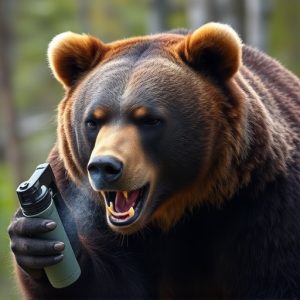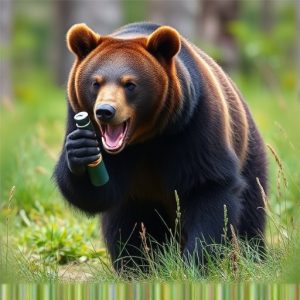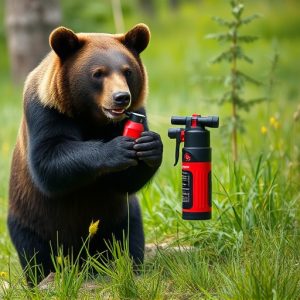Unveiling Bear Spray’s Fog Pattern: Power and Effective Use
Understanding the unique fog pattern of bear spray is key for self-defense in Alaska's wilderne…….
Understanding the unique fog pattern of bear spray is key for self-defense in Alaska's wilderness, where it outperforms pepper spray due to higher capsaicin concentration and additional chemicals. Factors like active ingredients, distance, wind conditions, and environment impact effectiveness. Bear spray creates a protective barrier against bears, while pepper spray offers localized effects. Proper usage of bear spray, through an "S" pattern application, ensures broad protection against aggressive bears, making it a vital backup option in dangerous situations.
In the vast wilderness of Alaska, encountering a bear can be a life-altering event. Understanding the fog pattern of bear spray is crucial for navigating these encounters safely. This article delves into the science behind bear spray fog, exploring how its effectiveness compares to pepper spray. We analyze factors influencing spray intensity and provide best practices for optimal use. By understanding these dynamics, folks can make informed decisions in bear country, ensuring their safety in the face of potential threats, especially when considering if bear spray is stronger than pepper spray.
- Understanding Bear Spray Fog Pattern and Its Efficacy
- Factors Influencing the Strength of Bear Spray
- Pepper Spray vs Bear Spray: A Comparison
- Best Practices for Using Bear Spray Effectively
Understanding Bear Spray Fog Pattern and Its Efficacy
Understanding the bear spray fog pattern is crucial when it comes to effective self-defense in Alaska’s rugged wilderness. Unlike direct sprays that hit a target in a concentrated stream, bear spray creates a mist or fog that spreads widely upon release. This unique delivery system ensures that the irritants reach not only the bear but also its sensitive eyes and respiratory system, even at a distance. The fog pattern allows users to apply the spray from safer angles, making it an effective deterrent against aggressive bears without necessarily coming into close contact.
When comparing bear spray to pepper spray, it’s important to note that while pepper spray is potent, bear spray is designed specifically for larger animals like bears. Its formulation and can design incorporate features like a wider mist distribution and increased irritants per can, making it generally more effective at deterring bears than standard pepper spray. This enhanced efficacy is vital in situations where every second counts during encounters with potentially dangerous wildlife.
Factors Influencing the Strength of Bear Spray
The effectiveness of bear spray, often referred to as a defense against aggressive bears in Alaska and beyond, depends on several factors. One common question is whether bear spray is stronger than pepper spray used for human self-defense. The strength of bear spray isn’t measured in the same way as traditional pepper spray, focusing instead on its ability to create a protective barrier and deter an attack.
Key influences include the type and concentration of active ingredients, the proximity of the applicator to the bear, and environmental conditions like wind speed and temperature. In Alaska’s unique environment, factors like humidity and air pressure can also play a role in how well bear spray performs. Understanding these variables is crucial for folks venturing into bear country to ensure they’re prepared with the most effective bear spray for their needs.
Pepper Spray vs Bear Spray: A Comparison
When considering self-defense options in the wild, understanding the differences between pepper spray and bear spray is essential. While both are designed to deter aggressive animals, their composition and effectiveness vary significantly. Pepper spray, a common choice for personal safety, uses capsaicin, the active ingredient found in chili peppers, to cause temporary blindness, coughing, and difficulty breathing. Its impact is usually localized and rapidly dissipates in the air.
In contrast, bear spray is specifically formulated to protect against bears. It contains a stronger concentration of capsaicin and other chemicals designed to disrupt a bear’s sense of smell and vision. The fog pattern created by bear spray can reach distances up to 30 feet, providing a wider area of protection. Studies suggest that bear spray is more effective in deterring bears due to its unique composition and extended duration of effect, which makes it a superior choice for navigating bear country.
Best Practices for Using Bear Spray Effectively
When it comes to effectiveness, bear spray isn’t just about strength—it’s about proper usage. Unlike traditional pepper spray, which can be sprayed directly into eyes and faces, bear spray is designed for large-scale protection. The ideal fog pattern should coat the animal from head to toe, creating a barrier that deters an attack. It’s crucial to practice the “S” pattern: sweep from side to side, low to high, covering all areas accessible by the bear.
A common misconception is that bear spray is stronger than pepper spray. While it can certainly be more effective against bears due to its unique formulation and specific application method, direct comparisons are tricky. What matters most is understanding your equipment and practicing until it becomes second nature—especially in situations where every second counts. Remember, the best defense is always prevention through awareness and distance, but bear spray offers a crucial backup option when needed.
In understanding the bear spray fog pattern and its efficacy, along with factors influencing its strength (including comparisons to pepper spray), it’s clear that proper usage is key. By adhering to best practices, such as aiming for the face and eyes, individuals can maximize the effectiveness of bear spray during encounters. While questions remain about whether bear spray is stronger than pepper spray, the unique properties of bear spray make it a crucial tool in defending against potential threats in Alaska’s wild landscapes.


